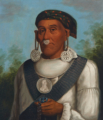The exhibition, After Removal: Rebuilding the Cherokee Nation, tells the story of the Cherokee Nation in the 19th century through the stark contrasts of the human experience — discord and harmony, war and peace, success and failure — and in the end, the creation of a solid foundation for the future of the Cherokee people.
Beginning in the late 18th century, Cherokee leaders embarked on a new strategy to facilitate government-to-government relations by creating institutions comparable to those of the United States. Within a few decades, the Cherokee had established executive positions with the formalized titles of Principal Chief and Deputy Principal Chief, in addition to instituting a national police force, a bicameral legislature, judicial districts, a supreme court, a written constitution and a national bilingual newspaper called the Cherokee Phoenix. These advancements were bolstered by widespread literacy that came about with the 1821 introduction of the Cherokee writing system, called the “Sequoyah Syllabary.”
Despite the adaptive efforts of the Cherokee and other tribes, the federal government and officials of many states were determined to remove all Indians from their homelands. In 1830, Congress passed the Indian Removal Act, authorizing the forced removal of 46,000 Native Americans from their ancestral lands. The Cherokee Nation, along with many supporters, including Henry Clay, Daniel Webster and David Crockett, made impassioned appeals against the removal. This exhibition spotlights the controversial and spirited debates conducted by key political figures of the day.
In 1835, the United States, unable to conclude a treaty with the duly-authorized representatives of the Cherokee Nation, recognized a minority faction as the new leaders and signed a treaty with them. The “so-called” treaty of New Echota ceded the last remaining portion of the Cherokee homeland east of the Mississippi and gave the Cherokee two years to voluntarily move to the Indian Territory (present day Oklahoma). When the time had elapsed in May 1838, only 2,000 of the 17,000 Cherokee subject to the treaty had removed. As a result, 7,000 federal and state troops descended on the Cherokee Nation to physically extricate 15,000 people. The journey to the west was arduous, with the very old and very young suffering the most. Thousands of people died along the way.
Those in opposition to the treaty blamed those who acquiesced for all the suffering and hardship, resulting in dissention and violence. More than 150 people were killed during several years of turmoil. The post-removal factionalism ended with the 1846 Treaty with the Cherokees, which offered a general amnesty to those involved in the post-removal violence. It also ushered in a period of great achievement and prosperity now referred to as the Golden Age of the Cherokee Nation. During this period, the Cherokee were able to re-affirm the commitment to a democratic, constitutional government and a national bilingual newspaper. The Cherokee created a public school system of 144 elementary schools and built two institutions of higher learning. The Cherokee capital of Tahlequah became a hub of commercial activity, and the nearby town of Park Hill experienced a cultural and intellectual renaissance.
Through art, material culture and manuscripts, this exhibition tells the fascinating story of resilience in the face of extreme adversity and the rebirth of the Cherokee Nation in what became known as “The Promised Land.”
After Removal: Rebuilding the Cherokee Nation is presented by Cherokee Nation with additional support from Bernstein Global Wealth Management and Piper and Deacon Turner.








